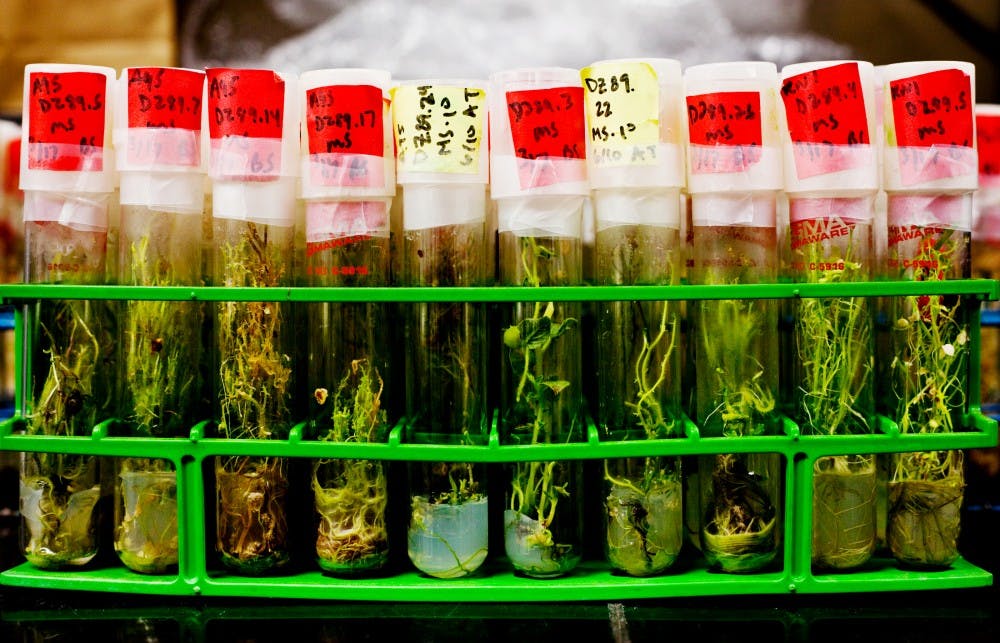But, in the time Sumerix has been at MSU, she said she already has seen her degree program change its name — from agricultural communications to its current title — and its overall focus.
Now, Sumerix said she thinks her major places less emphasis on agriculture than in the past.
“If I wanted a generalized major, I would have gone somewhere else,” she said.
The changes Sumerix has experienced are because of a college in transition.
Since late 2009, CANR administrators have taken an in-depth look at the college’s future, examining ways to deal with declining student enrollment, plunging state agricultural aid and cuts to more than 20 percent of MSU Extension educator positions, said Tom Coon, director of MSU Extension.
Underneath the surface, however, the college’s big picture is set to change during the next few years.
Students most likely will see at least one new department — a proposed merger between the Department of Crop and Soil Sciences and the Department of Plant Pathology — and some possible changes to curriculum and requirements.
The moves all spawn from a proposal initially developed in late 2009 by then-Dean Jeffrey Armstrong.
Armstrong’s vision for CANR would have consolidated 13 departments into eight, cut 25 percent of administrative staff, potentially shrunk south campus farm operations and left some students without degree programs.
Under Armstrong’s proposal, those moves would have affected the Department of Forestry and the School of Planning, Design and Construction. They eventually were avoided, but not without a time of indecision.
A little more than a month after presenting his proposal in November 2010 to CANR faculty and students, Armstrong left to become president at California Polytechnic State University in San Luis Obispo, Calif., leaving the college in an uncertain state.
In the months since Armstrong left and Doug Buhler stepped up to fill the interim dean position, college officials have backed off Armstrong’s proposal, instead choosing to pursue a different set of recommendations pushed forward by a new task force of seven CANR leaders.
The task force delivered a nine-page report to MSU Provost Kim Wilcox in February, discussing strategic initiatives dealing with repositioning instead of department cuts and personnel layoffs.
The college also completed an in-depth financial analysis of its campus field labs and farms, places where some students gain real-world agricultural experience.
Exact examples of some elements of the task force’s recommendations still have yet to play out, but college leaders emphasized that any realignment focuses more on strategy than on cutting faculty and staff positions.
Sumerix said she feels slightly better now about changes to her program, but fears MSU is beginning to slip away from its roots as an agricultural school.
“I like the way the university is thinking as far as trying to encompass a lot of different stuff,” she said. “However, at the same point, since we are a land-grant university … I think that the world maybe needs a wake-up call.”
Down to the roots
The land-grant roots Sumerix speaks of go back a long way. Agricultural curriculum in various forms dates back to the university’s inception.
Support student media!
Please consider donating to The State News and help fund the future of journalism.
That hasn’t kept students from choosing other majors.
CANR’s undergraduate student enrollment has fallen in six of the past 10 years, hitting a low point with 2,432 students enrolled in the college in 2003.
Even with an enrollment topping 3,300 students in 2007, CANR had a drop of 135 enrolled students in 2009, according to 2010 Data Digest numbers from the Office of Planning and Budgets.
“One of the things that we’re concerned about is the landscape of the students we recruit is changing,” Buhler said. “A lot of the students that … we need to recruit don’t know what horticulture means, don’t know what agronomy means, they don’t know what these things are.”
With that changing landscape in mind, the college began to consider more intensive restructuring details in 2010.
In March 2010, word got out the Department of Forestry would be folded into the Department of Fisheries and Wildlife under the proposal.
Some people associated with the college were opposed to Armstrong’s ideas from the early stages, said Richard Kobe, interim chair of the Department of Forestry.
“That was a plan that was developed really from Dean Armstrong’s vision and it didn’t really come up from the faculty and students,” he said.
Some alumni also expressed disdain for that portion of Armstrong’s proposal, including Bill Schmidt, president of the MSU Forestry Alumni Association.
Then-forestry department chair Daniel Keathley resigned in protest of the possible move in 2010, and Schmidt offered his own advice to administrators in an open letter directed at forestry alumni posted on the association’s website.
When discussing the potential restructuring, Schmidt said the MSU agricultural community was “standing on the edge of a chasm that threatens to eliminate a vital part of the reason for which Michigan State was instituted.”
He also encouraged alumni to personally voice their concerns with the proposal to Wilcox and MSU President Lou Anna K. Simon.
Bob Boehm, manager of the Michigan Farm Bureau Commodity and Marketing Department, said he and other agricultural industry members also were slightly skeptical as to the true benefits of such changes to CANR.
“The biggest question was what the cost savings would be,” he said. “As I recall, it wasn’t a lot.”
In the months following the response of Schmidt and others, the college backed off certain elements of Armstrong’s proposal, setting the stage for a Wilcox-appointed task force to take over the reshaping process in January 2011.
Convened by Steve Hanson, chair of the Department of Agricultural, Food and Resource Economics, the task force worked quickly and delivered its report to Wilcox on Feb. 21.
“For any of us (at MSU), if we don’t evolve continually and in the right ways, we’ll be at risk,” he said.
Measurable performance
Despite the emphasis on strategic positioning, the report did lay out some specific recommendations, including the merger of the Plant Pathology and Crop and Soil Sciences departments.
The task force’s report also recommended creating a new Department of Natural Resources, with faculty from three departments joining under that banner.
The recommendation for a Department of Natural Resources has since been pushed aside when it was determined faculty could work together out of their own departments, said Mike Jones, chair of the Department of Fisheries and Wildlife.
The merger of the Crop and Soil Sciences and Plant Pathology departments now is being pushed forward through academic governance, but no formal title for the department has been adopted and no faculty are slated to be cut because of the merger, said Jim Kells, chair of the Department of Crop and Soil Sciences.
The merger is expected to take effect July 1, 2012, and final approval of the new department lies with the MSU Board of Trustees.
The new department expects to retain all of its current staff and specific faculty assignments, and classes most likely will not change, Kells said.
The task force also laid out ways to shore up departmental administrative costs, from dealing with graduate student enrollment to faculty appointments.
That could mean consolidating business and human resource operations among units, Buhler said.
“You may ultimately retain a department as a unit, but that department may get its business services from a larger department,” he said. “We have to figure out how to get things done with fewer people.”
Aside from those two departments, other parts of the college already have undergone minor administrative changes.
The Department of Food Science and Human Nutrition and the Department of Entomology previously were jointly administered by both the College of Natural Science and CANR.
Now, CANR has full administrative control over both departments, Buhler said, but no faculty or programs have been changed or cut and no student programs have been affected.
World-grant or land-grant
In the process of reshaping itself for the future, CANR officials brought on an outside firm to conduct a thorough analysis and report on MSU’s agricultural operations.
Prepared by Lookout Ridge Consulting, the March 2011 report conducted interviews with dozens of university land and farm managers and outlined specific budget statistics.
Each of the nine units studied had combined operating expenses of about $1.9 million for this past fiscal year, according to information obtained through a Michigan Freedom of Information Act request.
To lead MSU’s nearby farm operations, Lookout Ridge recommended a South Campus Operations Manager be brought on to coordinate farm facilities and field work.
The report did not advocate for the sale of any campus farmland or extension properties.
Most industry personnel feel there are chances for improved dialogue with CANR, Boehm said, but the college must not lose its focus on local relationships.
“Obviously, the industry is not interested in trying to micromanage the university,” he said. “There’s a real need with some of the unique products and commodities we have. We really need to rely on our land-grant roots.”
Buhler said MSU’s commitment to land-grant ideals remains strong, despite the challenges CANR faces.
Buhler said he thinks the future of the college lies in “big science” research and the ability to solve fundamental agricultural problems. Those challenges might take different shapes over time, he added.
“I believe that the basic philosophy is there, and I believe the commitment is here,” he said. “Now, what form that takes because of funding issues and because of realities of competing as a Big Ten institution, (there are) going to be changes, and (there are) going to be challenges.”
For the time being, Sumerix said she plans to stay in her current degree program. Large transitional moves being pushed forward by CANR shouldn’t dilute the college’s overall purpose, she said.
“We’re not just cows and plows,” she said. “(Agriculture) still exists. We’re not getting rid of it.”
Discussion
Share and discuss “Changes on the horizon” on social media.





